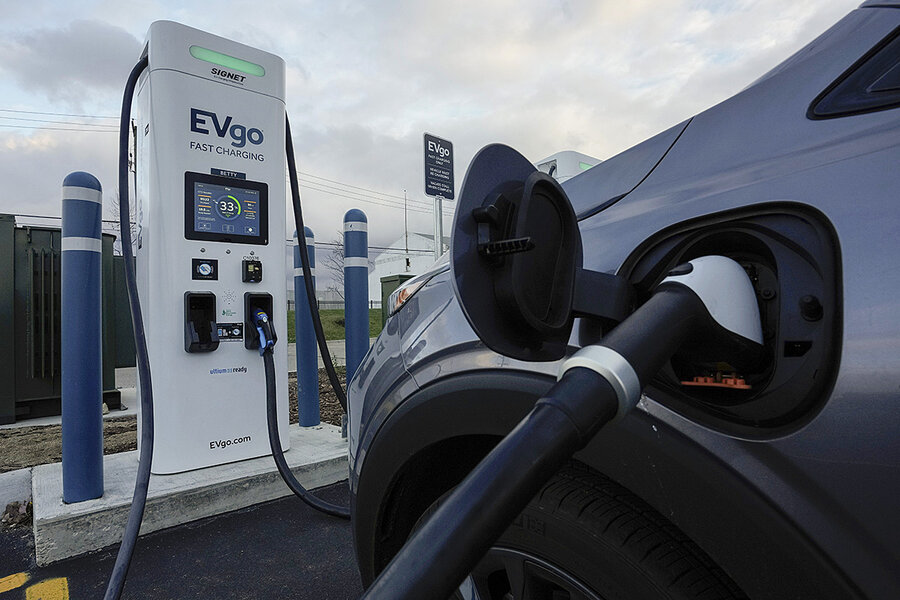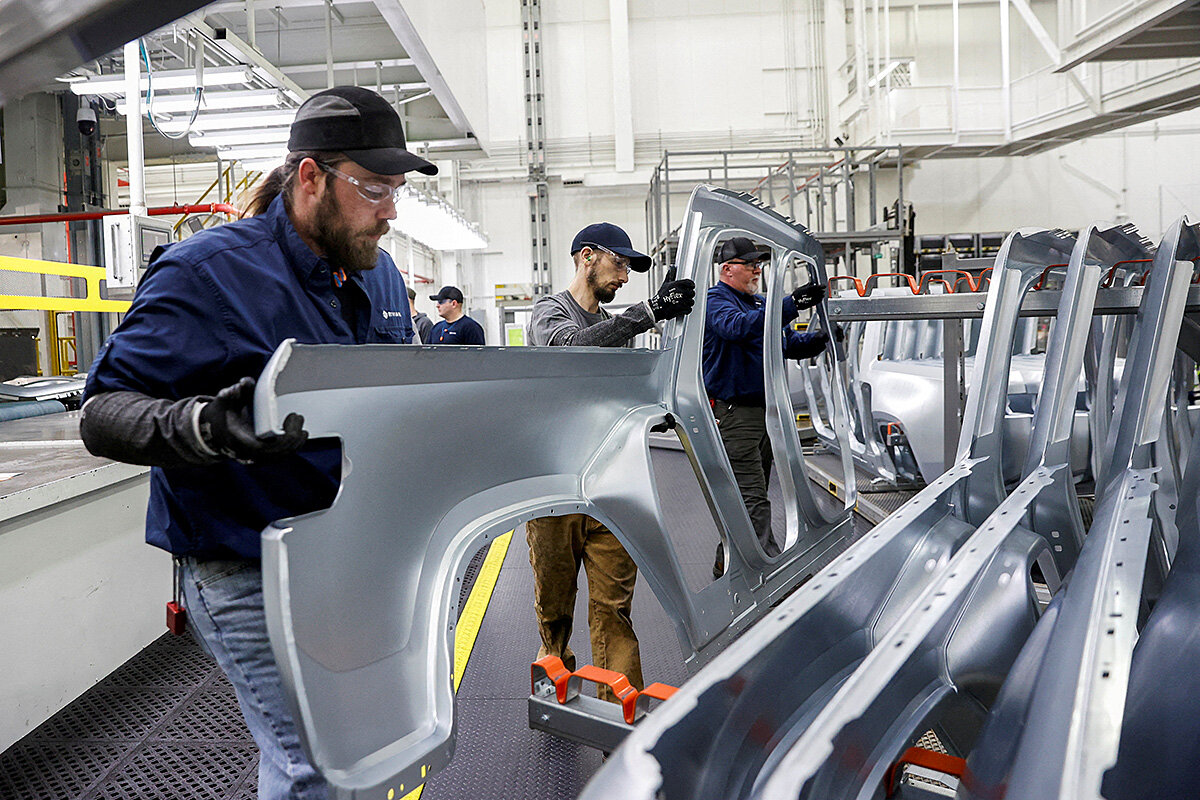Sticks plus carrots: How realistic is Biden’s electric-car target?
Loading...
On Saturday, Paul Collins finished his first long-distance road trip in his year-and-a-half-old Tesla. “It was amazingly easy. Convenient,” he says of the 2,800-mile round trip from his Wellesley, Massachusetts, home to Florida and back again.
The software told him not only the available charging stations along his route, but also the number of chargers available and the restaurants and other amenities around. He didn’t even have to pull out a credit card when he plugged in. The charger automatically identified his car, and Tesla automatically billed him.
He says he’s not concerned about the dramatic leap in electric vehicle sales that the Biden administration is seeking, through proposed tougher tailpipe emission standards announced Wednesday. In effect, the administration is calling for two-thirds of new car sales to be EVs by 2032, up from less than 6% last year. “I might have said before I bought this EV that it might seem impractical,” says Mr. Collins, manager of an investment company. “Having made this road trip, it feels quite practical.”
Why We Wrote This
A story focused onWith electric vehicles accounting for only about 6% of current new car sales in the United States, a Biden target of about two-thirds by 2032 may sound unrealistic. But experts don’t see it as an impossible reach.
Mary Beermann isn’t so sure. When she needed a new car, the Valparaiso, Indiana, retiree took a hard look at EVs. She visited several dealerships and even went to a car show in Chicago to check them out. But after friends sent her articles about the risks of EV batteries catching fire and problems disposing of the batteries once they’re used up, she decided last fall to buy a conventional Mazda instead.
“I was pretty happy with my decision,” she says. “It doesn’t mean I wouldn’t ever have [an EV].” She’s waiting for the technology to mature.
The proposed tightening of vehicle emission standards will test how much a major governmental push can transform the marketplace for a complex and costly product that Americans typically rely on every day. The “carrots” of federal rebates and other investments, combined with the “sticks” of tougher regulation of greenhouse gasses, will surely have an impact. Reaching the Biden administration’s goals isn’t impossible, but it remains a question whether the road ahead for EVs will track the experience of Mr. Collins or be more like that of Ms. Beermann.
“There’s a lot of momentum already. And what you see happening is the government trying to ensure that what the automakers said they’re going to do actually happens,” says Kenneth Gillingham, professor of energy and environmental economics at Yale University.
If the proposed package of rules becomes regulation and is successfully implemented, it would mean the United States would produce almost 10 billion fewer tons of carbon dioxide emissions through 2055, according to the Environmental Protection Agency. That’s the same as eliminating more than two years’ worth of all current U.S. CO2 emissions, the EPA says. The rules would also improve air quality, eliminate demand for 20 billion barrels of oil, and save the average car owner $12,000 in reduced fuel and maintenance costs over the lifetime of a car.
But it would also boost the upfront cost of a new car by some $1,200 by 2030.
New cars already cost consumers a lot of money, and some industry analysts warn of price hikes at a time when inflation is already a top public concern.
“If this … EV market share requirement is implemented, within the proposed time frame, it will impact every aspect of the auto industry in the form of lost jobs and dramatic price hikes for both EVs and gasoline models,” said Karl Brauer, executive analyst at iSeeCars, a Boston area car-search website, in a statement. “These increases will either drive the price of new vehicles beyond the average American’s budget or put multiple global automakers in financial peril. Likely both, in that order.”
Still, the industry itself is committed to going electric.
“The question isn’t can this be done, it’s how fast can it be done,” John Bozzella, CEO of the industry group Alliance for Automotive Innovation, wrote in a blog post. “How fast will depend almost exclusively on having the right policies and market conditions in place.”
Several major automakers have set goals of making EVs 40% to 50% of their new car sales in the U.S. by 2030, such as Honda, Nissan, Stellantis (owner of Fiat and Chrysler), and Ford. General Motors aims to be all-electric by 2035. And some European brands are even more aggressive. Mercedes expects to be all-electric by 2030. Even before Wednesday’s announcement, BloombergNEF was projecting that 52% of all U.S. new car sales would be EVs by 2030, thanks to federal legislation that extended federal subsidies for EV sales.
Those projections are not too far off from the low end of the administration’s new 2030 target of 54%. By adding the regulatory stick to the subsidy carrots the administration has already been offering, the U.S. could meet the new ambitious targets for EV sales, Dr. Gillingham says. There’s precedent for this.
Using a combination of fees and generous subsidies to make EVs cheaper than conventional cars, Norway saw EVs grab a nearly 87% share of new car sales last month. Still, starting in 2027, the new rules would force the fastest ratcheting up of fuel-emission standards in U.S. history.
In the U.S., a healthy majority of customers say they would be ready to buy a fully electric car by 2030, according to Dr. Gillingham’s research, which is not yet published.
Of course, there are potential bumps along the way that could disrupt such forecasts, especially because they’re based on estimates of technological breakthroughs that haven’t happened yet. Supply chain problems, shortages of critical minerals for batteries, and other challenges could also slow the momentum.
Federal incentives of as much as $7,500 for buying an electric car can help nudge consumers, but they are becoming less available due to a different policy priority: reducing U.S. dependence on China and other countries for batteries.
Another major looming issue is the network of charging stations. If it doesn’t grow fast enough, EV drivers on a trip will have to wait for a procedure that already takes far longer than filling up at a gas tank. Mr. Collins estimates he spent 25 to 30 minutes for each recharge of his Tesla on his recent Florida trip and had to wait no longer than 30 seconds to plug in. But if more EVs hit the road and as Tesla opens up its network to non-Tesla drivers, he worries that the wait times will lengthen.
The Biden administration has allocated $2.5 billion to encourage the building of 500,000 charging stations by 2030, 10 times today’s number. Estimates of the need run into the millions.
And the distribution of those chargers is unequal. EV leader California has more than 14,000, according to the U.S. Department of Energy. South Dakota has 73. And it’s in very rural places like South Dakota as well as highly dense urban locations where EVs might meet the most resistance. Apartment dwellers in New York City, for example, may not have the at-home chargers they’d need if they owned an EV. And rural ranchers and contractors, used to driving hundreds of miles at a time, may find recharging their vehicles especially inconvenient.
In a survey last year, Dr. Gillingham found that pickup drivers were less likely than either car owners or SUV owners to embrace electrification. While some 40% were eager to switch and another 30% were convincible, the rest were not. “There was a group of truck buyers who will not be buying electric trucks for a long time,” he says.








